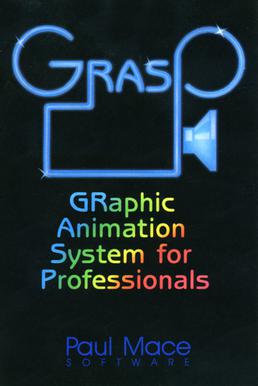
The Graphics Interchange Format is a bitmap image format that was developed by a team at the online services provider CompuServe led by American computer scientist Steve Wilhite and released on June 15, 1987. It is in widespread usage on the World Wide Web due to its wide support and portability between applications and operating systems.

The Original Chip Set (OCS) is a chipset used in the earliest Commodore Amiga computers and defined the Amiga's graphics and sound capabilities. It was succeeded by the slightly improved Enhanced Chip Set (ECS) and the greatly improved Advanced Graphics Architecture (AGA).

Portable Network Graphics is a raster-graphics file format that supports lossless data compression. PNG was developed as an improved, non-patented replacement for Graphics Interchange Format (GIF)—unofficially, the initials PNG stood for the recursive acronym "PNG's not GIF".
PCX, standing for PiCture eXchange, was an image file format developed by the now-defunct ZSoft Corporation of Marietta, Georgia, United States. It was the native file format for PC Paintbrush and became one of the first widely accepted DOS imaging standards, although it has since been succeeded by more sophisticated image formats, such as BMP, JPEG, and PNG. PCX files commonly stored palette-indexed images ranging from 2 or 4 colors to 16 and 256 colors, although the format has been extended to record true-color (24-bit) images as well.
In computer graphics, planar is the method of arranging pixel data into several bitplanes of RAM. Each bit in a bitplane is related to one pixel on the screen. Unlike packed, high color, or true color graphics, the whole dataset for an individual pixel is not in one specific location in RAM, but spread across the bitplanes that make up the display. Planar arrangement determines how pixel data is laid out in memory, not how the data for a pixel is interpreted; pixel data in a planar arrangement could encode either indexed or direct color.
The BMP file format or bitmap, is a raster graphics image file format used to store bitmap digital images, independently of the display device, especially on Microsoft Windows and OS/2 operating systems.

Interleaved Bitmap (ILBM) is an image file format conforming to the Interchange File Format (IFF) standard. The format originated on the Amiga platform, and on IBM-compatible systems, files in this format or the related PBM format are typically encountered in games from late 1980s and early 1990s that were either Amiga ports or had their graphical assets designed on Amiga machines.

The Color Graphics Adapter (CGA), originally also called the Color/Graphics Adapter or IBM Color/Graphics Monitor Adapter, introduced in 1981, was IBM's first color graphics card for the IBM PC and established a de facto computer display standard.

Hold-And-Modify, usually abbreviated as HAM, is a display mode of the Commodore Amiga computer. It uses a highly unusual technique to express the color of pixels, allowing many more colors to appear on screen than would otherwise be possible. HAM mode was commonly used to display digitized photographs or video frames, bitmap art and occasionally animation. At the time of the Amiga's launch in 1985, this near-photorealistic display was unprecedented for a home computer and it was widely used to demonstrate the Amiga's graphical capability. However, HAM has significant technical limitations which prevent it from being used as a general purpose display mode.
An image file format is a file format for a digital image. There are many formats that can be used, such as JPEG, PNG, and GIF. Most formats up until 2022 were for storing 2D images, not 3D ones. The data stored in an image file format may be compressed or uncompressed. If the data is compressed, it may be done so using lossy compression or lossless compression. For graphic design applications, vector formats are often used. Some image file formats support transparency.

In computer graphics, a palette is the set of available colors from which an image can be made. In some systems, the palette is fixed by the hardware design, and in others it is dynamic, typically implemented via a color lookup table (CLUT), a correspondence table in which selected colors from a certain color space's color reproduction range are assigned an index, by which they can be referenced. By referencing the colors via an index, which takes less information than needed to describe the actual colors in the color space, this technique aims to reduce data usage, including processing, transfer bandwidth, RAM usage, and storage. Images in which colors are indicated by references to a CLUT are called indexed color images.
In computing, indexed color is a technique to manage digital images' colors in a limited fashion, in order to save computer memory and file storage, while speeding up display refresh and file transfers. It is a form of vector quantization compression.
PC Paintbrush was a graphics editing software created by the ZSoft Corporation in 1984 for computers running the MS-DOS operating system.

PCPaint was the first IBM PC-based mouse-driven GUI paint program. It was developed by John Bridges and Doug Wolfgram. It was later developed into Pictor Paint.

GRaphic Animation System for Professionals (GRASP) was the first multimedia animation program for the IBM PC family of computers. It was also at one time the most widely used animation format.
John Bridges is the co-author of the computer program PCPaint and primary developer of the program GRASP for Microtex Industries with Doug Wolfgram. He is also the sole author of GLPro and AfterGRASP. His article entitled "Differential Image Compression" was published in the February 1991 issue of Dr. Dobb's Journal.
BSAVE and BLOAD are commands in many varieties of the BASIC programming language. BSAVE copies RAM to a binary file, and BLOAD copies the contents of the file to RAM. The term "BSAVE image" could mean any of various raw image formats of video display controllers, or more generally any file containing the raw contents of a section of memory.
QuickTime Graphics is a lossy video compression and decompression algorithm (codec) developed by Apple Inc. and first released as part of QuickTime 1.x in the early 1990s. The codec is also known by the name Apple Graphics and its FourCC SMC. The codec operates on 8-bit palettized RGB data. The bit-stream format of QuickTime Graphics has been reverse-engineered and a decoder has been implemented in the projects XAnim and libavcodec.








